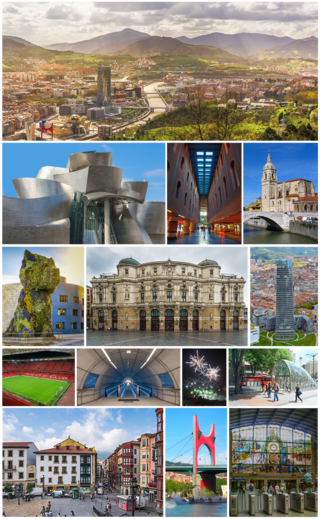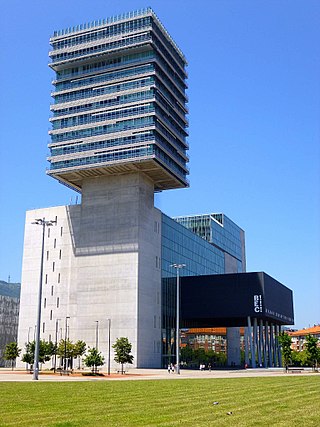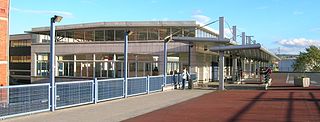
Bilbao is a city in northern Spain, the largest city in the province of Biscay and in the Basque Country as a whole. It is also the largest city proper in northern Spain. Bilbao is the tenth largest city in Spain, with a population of more than 347,000 as of 2023. The Bilbao metropolitan area has 1,037,847 inhabitants, making it the most populous metropolitan area in northern Spain; with a population of 875,552, the comarca of Greater Bilbao is the fifth-largest urban area in Spain. Bilbao is also the main urban area in what is defined as the Greater Basque region.

Euskotren Trena, formerly known just as Euskotren is a commuter, inter-city and urban transit train-operating company that operates local and inter-city passenger services in the provinces of Biscay and Gipuzkoa, in the Basque Country, Spain. It is one of the four commercial brands under which Euskotren operates, as a public company managed by the Basque government. The entire 181.1-kilometre (112.5 mi) network uses 1,000 mm narrow gauge rail tracks which have been owned by the Basque Government since their transferral from the Spanish government; the rail tracks and stations were part of the FEVE network until its transferral. Euskotren Trena also operates the Donostia/San Sebastián metro under the brand Metro Donostialdea.

Barakaldo is a municipality located in the Biscay province in the Basque Country in Spain. Located on the Left Bank of the Estuary of Bilbao, the city is part of Greater Bilbao, has a population as of the 2019 census at 100,881. Barakaldo has an industrial river-port heritage and has undergone significant redevelopment with new commercial and residential areas replacing the once active industrial zones.

Erandio is a town and municipality located in the province of Biscay, in the autonomous community of Basque Country, northern Spain.

Getxo is a town located in the province of Biscay, in the autonomous community of the Basque Country, in Spain. It is part of Greater Bilbao, and has 75,430 inhabitants (2023). Getxo is mostly an affluent residential area, as well as being the third largest municipality of Biscay.
Greater Bilbao is an administrative division of the province of Biscay, in the Basque Country, Spain. It is one of the seven comarcas of Biscay and the most populated. The capital city of Greater Bilbao is Bilbao.
The Estuary of Bilbao lies at the common mouth of the rivers Nervion, Ibaizabal and Cadagua, which drain most of Biscay and part of Alava in the Basque Country, Spain. In this instance, the Spanish word estuario is used to describe what in English would normally be called part estuary, part tidal river. The estuary becomes a tidal river which extends 16 km (9.9 mi) into the city of Bilbao, starting from the Bilbao Abra bay. It hosts the port of Bilbao throughout its length, although the Port Authority has recently restored most of the upper reaches to Bilbao and other municipalities for their urban regeneration. The port is now being transferred to the seaboard on the coast at Santurtzi and Zierbena.

Basauri is a major municipality of Biscay, in the Basque Country, an Autonomous Community in northern Spain.

The Merindad de Uribe or Uribealdea is a historical subdivision of Biscay, Basque Country, Spain. It contained most of the municipalities now within the comarca of Greater Bilbao in the Bilbao metropolitan area. The parts of Uribe which now fall under Greater Bilbao are:

Deusto, also known as Deustu in Basque and formerly known as San Pedro de Deusto, is one of the eight districts of Bilbao, Spain. It is located on the right side of the Bilbao estuary, in the northwestern part of the city and bordering the estuary itself on the south and the southern hillside of Mount Artxanda and Mount Bandera on the north. Deusto was originally an elizate and also a municipality until 1925 when it was completely annexed by Bilbao in order to expand the free land available to the city. Deusto is known as the university district of the city as it is home to the University of Deusto and the Faculty of Economics and Business of the University of the Basque Country.

The Abando Indalecio Prieto railway station, usually known simply as Bilbao-Abando and previously known as Estación del Norte is a terminal railway station in Bilbao, Basque Country (Spain). The name comes from Abando, the district in which the station is located, and Indalecio Prieto, who was Minister of Public Works during the Second Spanish Republic. The station serves as the terminus station for several long and medium distance services operated by Renfe as well as commuter rail services within the Bilbao metropolitan area operated by Cercanías. The station has direct access to Metro Bilbao and to the tram, as well as many local and regional bus lines. The railway station Bilbao-Concordia, operated by Renfe Feve is located in close proximity. After the construction of the high-speed line Basque Y is finished, Bilbao-Abando will serve as the western terminus, which will involve the creation of a completely new station replacing the current one.

Lutxana is a station of line 1 of Metro Bilbao, also served by the Lutxana-Sondika shuttle operated by Euskotren Trena. It is located in the neighbourhood of Lutxana-Enekuri, in the municipality of Erandio. In its current inception, the station was opened on 11 November 1995. Since 2015, the station has also been served by Euskotren Trena suburban trains.

Erandio is a station on line 1 of the Bilbao metro. It is located in the neighborhood of Altzaga, in the municipality of Erandio. The station opened as part of the metro on 11 November 1995.

Leioa is a station on line 1 of the Bilbao metro. It is located in the neighborhood of Udondo, in the municipality of Leioa. The station opened as part of the metro on 11 November 1995, replacing an older station. It is located next to a park and ride facility.

Lamiako is a station on line 1 of the Bilbao metro. It is located in the neighborhood of Lamiako, in the municipality of Leioa. The station opened as part of the metro on 11 November 1995, replacing an older station.

The Bilbao Metropolitan Area is the metropolitan area or continuous urban area based around the city of Bilbao, in the Basque Country, Spain. It comprises the city of Bilbao, the 25 municipalities that make the comarca of Greater Bilbao plus ten other surrounding municipalities, all of them in the province of Biscay.
Association football has been a part of Basque Country culture since the end of the 19th century. As of 2023, three Basque teams play in La Liga, the top division of the Spanish football system: Athletic Bilbao, Real Sociedad and Deportivo Alavés.
The 1894 Bilbao students v British workers was a football match that took place at the Hippodrome of Lamiako, Leioa, on 3 May 1894. The match was contested by a group of Bilbainos who challenged the British residents in Bilbao to a football match, which at the time was a relatively unknown sport in Spain. The game was won comfortably by the British 5–0, but more important than the result was its historical significance, as it was probably one of the first ‘international’ matches in the history of the sport.

The Limiako Hippodrome, or the Hippodrome of Lamiako, was a sports venue based in the Lamiako neighborhood of Leioa, Biscay, Basque Country. Originally an equestrian venue, it's now best remembered as a historic football venue. The Campo de Lamiako played a pivotal role in the early steps of football in the Basque Country as one of the first football fields in the city, serving as a practice ground for the city’s first known football matches between the members of the Club Atleta of the Nervión Shipyards. In 1894, the Limiako field hosted a match between young Bilbao enthusiasts and British workers, which is now regarded as one of the first ‘international’ matches in the history of the sport.



















